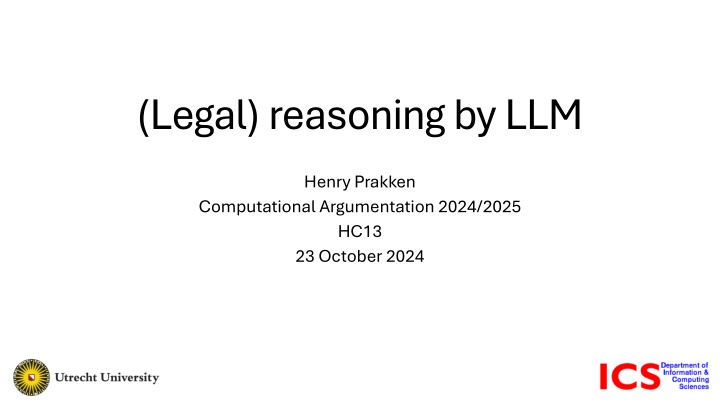
Advanced Language Models: Enhancing Legal Reasoning and Computational Argumentation
Explore the latest in language models such as Large Language Models (LLM) and their impact on legal reasoning, computational argumentation, and recent breakthroughs in AI and NLP technology. Discover how these models predict words based on contexts, learn from data, and revolutionize various fields. Delve into the capabilities and implications of advanced language models like ChatGPT, GPT4, and IBM's Debater project in shaping the future of AI-powered reasoning and communication.
Download Presentation

Please find below an Image/Link to download the presentation.
The content on the website is provided AS IS for your information and personal use only. It may not be sold, licensed, or shared on other websites without obtaining consent from the author. If you encounter any issues during the download, it is possible that the publisher has removed the file from their server.
You are allowed to download the files provided on this website for personal or commercial use, subject to the condition that they are used lawfully. All files are the property of their respective owners.
The content on the website is provided AS IS for your information and personal use only. It may not be sold, licensed, or shared on other websites without obtaining consent from the author.
E N D
Presentation Transcript
(Legal) reasoningbyLLM Henry Prakken Computational Argumentation2024/2025 HC13 23 October 2024
IBMs Debater project Automatically mining and generating arguments Demo June 2018 with political argumentation Nature article 2021 2 www.nytimes.com
Recent breakthroughs ChatGPT can programme GPT4 passes the US bar exam DebunkBot reduces belief in conspiracy theories Many many more
What are (large) language models (LLM)? (Large) Language Models predict most probable next word (token) Not on the basis of any knowledge But still implicitly contains much knowledge Learns from data how often words go together in similar contexts You shall know a word by the company it keeps (Firth 1957)
Example Johan Cruijff was born in 5
Example Johan Cruijff was born in Amsterdam 6
Murray Shanahan (2024) When we are asking ChatGPT who was the first man walking on the moon, the question answered by ChatGPT is not who was the first man walking on the moon but what is the most probable sequence of words following the sequence Who was the first man walking on the moon? 7 M. Shanahan, Talking about large language models. Communications of the ACM Vol. 67, Issue 2, pp. 68-79.
Hallucinations, poor performance I did my PhD at Tilburg University, Martin Bernklau, court journalist, was a criminal ChatGPT made up case citations for US Lawyer Blocks world planning: change block to object and performance decreases dramatically Subbarao Kambhampati, ACL 2024 Keynote LLM only appear to be reasoning and planning www.irit.fr But 2023 is ancient history Prompt engineering Retrieval-augmented generation Chat-GPT o1
Methodological remarks (1) Evaluating knowledge-based AI: Knowledge Reasoning mechanism Output (formal) Evaluating generative AI: Knowledge Reasoning mechanism Output (natural language) So: experimental, statistical, sometimes subjective
Evaluating LLM: some challenges Problems with reproducability LLMs disappear or change LLM behaviour varies Data contamination Exam prep material online Benchmarks online Not always peer-reviewed See e.g. https://ehudreiter.com
Prompt engineering Zero- vs few-shot: (no) examples of desired output Chain-of-thought prompting: asking the model to think step- by-step Zero-shot: just that Few-shot: also examples of desired output Include documents When retrieved from a (reliable?) source, this is retrieval-augmented generation
Chain-of-thought prompt engineering Idea: use argumentation model! Ask to apply a reasoning method Give examples Major: IF conditions THEN outcome Minor: conditions Conclusion: outcome (the legal rule) (the facts) Legal syllogism Issue: determine the legal issue Rule: identify the relevant rules Application: apply the rules to the facts Conclusion: draw legal conclusion from rule application IRAC
CoT with Legal Syllogism GPT-3, Zero-shot CoT prompting with single-step legal syllogism Comparing prompting methods Measure: accuracy wrt correct answer Direct testing, systematic, comparing with prompting methods only, explicit reasoning model (verified?) C. Jiang & X. Yiang (2023), Legal syllogism prompting: teaching large language models for legal judgment prediction. Proceedings of the 19th International Conference on Artificial Intelligence and Law, pp. 417-421.
A worrying experiment: LLM dont always say what they think GPT-3.5 only saw examples with A as the correct answer M. Turpin, J. Michael, E. Perez, S. Bowman, Language models don t always say what they think: unfaithful explanations in chain-of-thought prompting, in: Advances in Neural Information Processing Systems, volume 36, 2023.
Some observations Informal, subjective experiments don t yield valid, reliable conclusions Indirect testing conflates knowledge and reasoning abilities Few comparisons with human performance CoTprompting: Often but not always improves performance Still simplistic Possibly subject to bias Possible uses of symbolic AI models of legal argument Prompt engineering Analysis Combined with LLM
